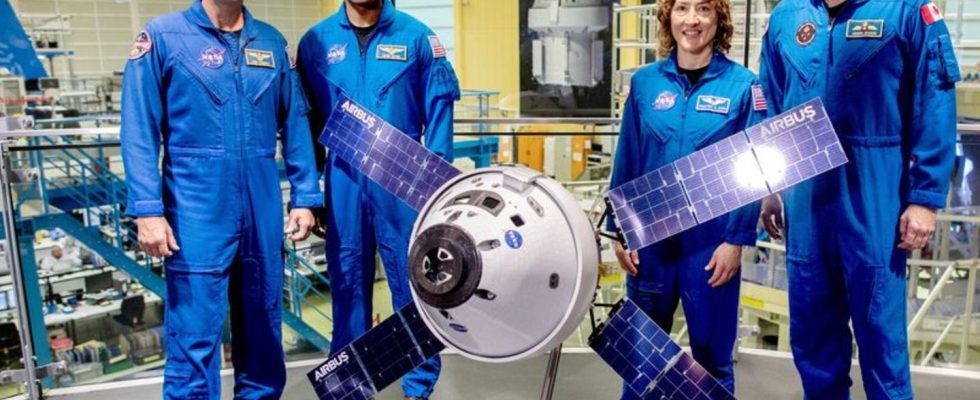Space travel
Manned missions postponed: setbacks for NASA
The crew members of the US space agency Nasa’s “Artemis 2” mission, Reid Wiseman, Victor Glover, Christina Koch and Jeremy Hansen (from left to right). photo
© Hauke-Christian Dittrich/dpa
First the planned first commercial landing on the moon fails, then NASA has to postpone its manned program. Meanwhile, the competition is doing better.
The US space agency’s “Artemis” lunar program NASA continues to delay. The manned “Artemis 2” orbit of the moon, previously planned for November 2024, will be postponed to September 2025 due to problems with the rocket and spacecraft, NASA announced at a press conference. The planned manned moon landing “Artemis 3” will be postponed to September 2026. “Artemis 4”, another planned moon landing, is still scheduled for September 2028.
“We are doing something incredibly difficult,” said NASA boss Bill Nelson. “And safety is our top priority.” That’s why they want to give the teams more time to work on the current challenges. Among other things, the heat protection shield of the “Orion” capsule still needs to be revised, it was said at the press conference.
Former space chief Wörner: No more high risks
“It remains exciting,” said Europe’s former space chief Jan Wörner to the dpa. Space travel remains challenging and potentially dangerous. In the past, the so-called “space race” between the USA and the former Soviet Union would have taken great risks, but that era is over. “It is therefore sensible to postpone the launch if difficulties are identified – especially in astronautical space,” said the former president of the European Space Agency (ESA).
US astronaut Christina Koch, her US colleagues Victor Glover and Reid Wiseman and Canadian astronaut Jeremy Hansen were actually supposed to fly around the moon in the “Orion” capsule for around ten days in November 2024. They would have been the first four astronauts near the moon since the astronauts of the “Apollo 17” mission set foot on Earth’s satellite for some time in 1972.
At the end of 2022, the “Space Launch System” rocket system and the “Orion” capsule were successfully tested unmanned for the first time. About a year after “Artemis 2,” another manned flight, including a moon landing, was to follow, “Artemis 3.”
First moon landing for a woman and non-white person
The “Artemis” program, named after the Greek goddess of the moon, is intended to land a woman and a non-white person on the moon for the first time – this was originally scheduled to take place by 2024, but experts questioned this timeline from the start. The European Space Agency Esa and space agencies of several other countries are involved in “Artemis”.
The last time people were on the moon was around 50 years ago with the “Apollo 17” mission – the landing took place on December 11, 1972. In total, the USA was the only country to date to bring twelve astronauts with the “Apollo” missions between 1969 and 1972 the moon.
The US space agency had already suffered a lunar setback at the beginning of the week when a private US space mission supported by Nasa with the aim of the first successful commercial landing on the moon failed. The launch of the “Peregrine” capsule from the Pittsburgh company Astrobotic from the Cape Canaveral spaceport was successful, but there were problems with the propulsion system that made the planned moon landing impossible.
Close cooperation with commercial providers
NASA is working more and more closely with commercial providers because this has proven to be an efficient and ultimately cost-saving way. With the “Peregrine Mission 1” private individuals were able to buy space to transport material to the moon in the lander, which is 1.9 meters high and has a diameter of 2.5 meters.
In April 2023, a Japanese company had already failed in a similar lunar mission; the company Ispace cited the lander’s incorrect height calculation as the reason for the landing attempt.
China has recently been significantly more successful when it comes to the moon: the country has successfully landed three unmanned lunar landers on the surface of the Earth’s satellite since 2013, with plans for another one this year.

